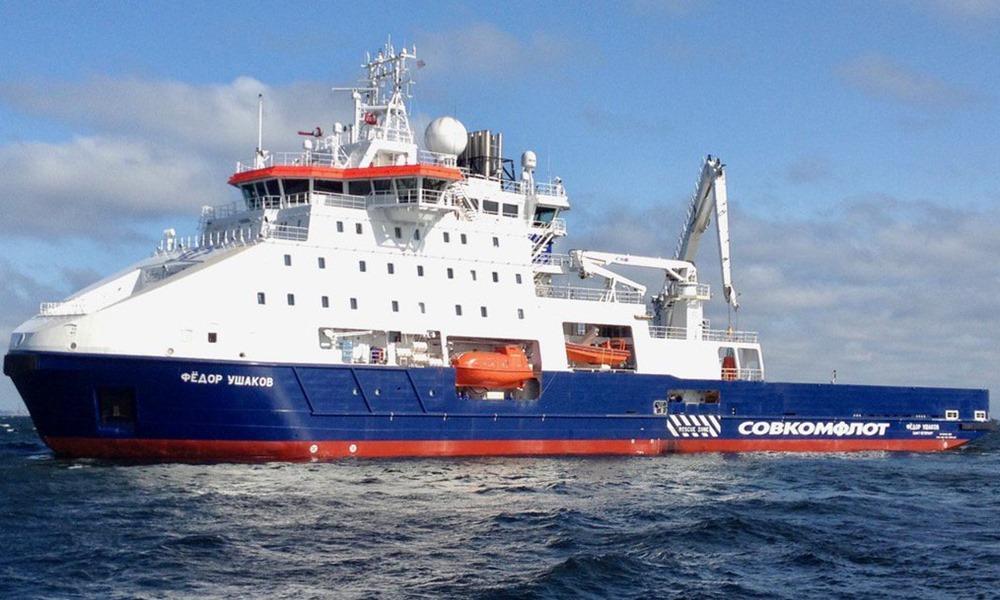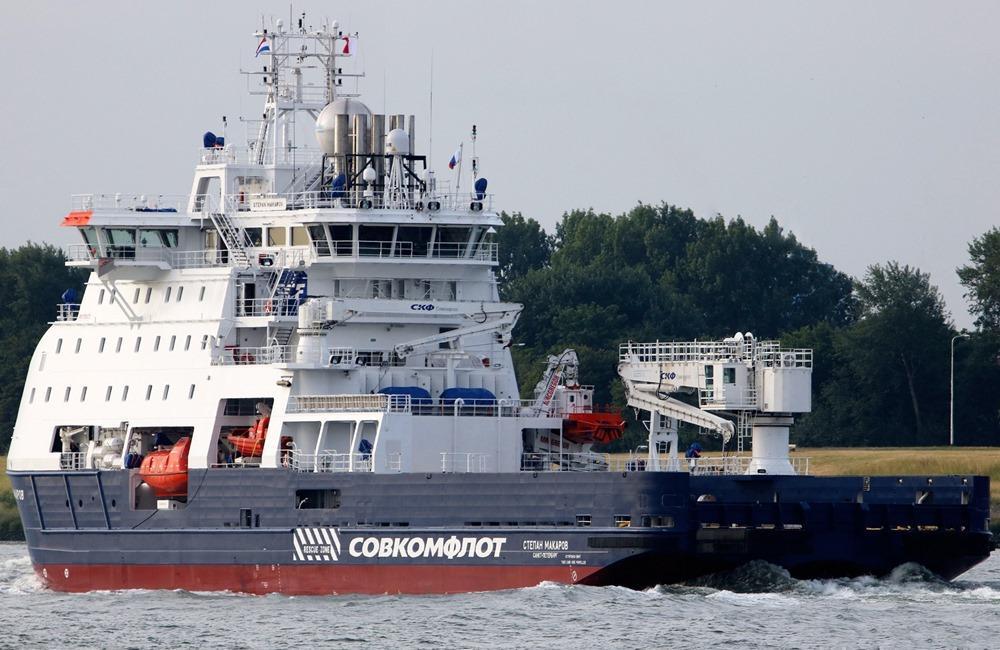Fedor Ushakov icebreaker
Fedor Ushakov icebreaker current position
The current location of Fedor Ushakov icebreaker is in East Asia cruising en route to PA-A. The AIS position was last reported 33 minutes ago.
Current PositionSpecifications of Fedor Ushakov icebreaker
| Year of build | 2017 / Age: 8 |
| Flag state | Russia |
| Builder | Arctech Helsinki Shipyard (Helsinki, Finland) |
| Class | Arctech Icebreaking Supply Vessel |
| Ferry route / homeports | Vladivostok |
| Building cost | USD 100 million |
| Engines (power) | Wartsila (21 MW / 28161 hp) |
| Propulsion power | 15.6 MW / 20920 hp |
| Speed | 16 kn / 30 km/h / 18 mph |
| Length (LOA) | 104 m / 341 ft |
| Beam (width) | 21 m / 69 ft |
| Gross Tonnage | 8626 gt |
| Passengers | 42 |
| Crew | 28 |
| Beds | 70 |
| Cabins | 45 |
| Sister-ships | Stepan Makarov, Gennadiy Nevelskoy, Yevgeny Primakov |
| Christened by | Tatyana Timchenko |
| Owner | SCF Sovcomflot (Russia) |
| Operator | SCF Sovcomflot (Russia) |
Fedor Ushakov icebreaker Review
Review of Fedor Ushakov icebreaker
The 2017-built MS Fedor Ushakov ("ледокол Фёдор Ушаков") is an icebreaking vessel owned by SCF Sovcomflot (Совкомфлот/fleet) and operated through the subsidiary SCF Sakhalin Vessels Ltd. Sovcomflot is a Russian state-owned corporation specializing in petroleum and LNG shipping.
The vessel (IMO number 9753739, Helsinki Shipyard/hull number 513) is Russia-flagged (MMSI 273396260) and homeported in Vladivostok.
The icebreaker serves as a supply vessel for Russia’s Sakhalin-2 oil and gas field on Sakhalin Island (Okhotsk Sea, northwestern Pacific Ocean). She is named after Admiral Fyodor Fyodorovich Ushakov (1745-1817, Imperial Russian Navy service 1766-1812). After Russia annexed Crimea in 1783, Ushakov supervised the construction of the Sevastopol naval base and the docks at Kherson. During the Russo-Turkish War (1787-1792), he defeated enemy fleets in the battles of Fidonisi, Kerch Strait, Tendra, and Cape Kaliakra.
Sovcomflot (Совкомфлот, founded 1988) is Russia’s largest shipping company, specializing in hydrocarbon transportation (HGLs – hydrocarbon gas liquids) from the Arctic. Of the fleet’s ~150 vessels, more than 80 are ice-classed with icebreaking capabilities.
History and construction
This Russian icebreaker class was designed by Arctech Helsinki Shipyard (Helsinki, Finland) as a supply vessel. It represents a 4-ship series of IBSBV ("icebreaking standby vessel") with sisterships Gennadiy Nevelskoy, Stepan Makarov, and Yevgeny Primakov.
The earlier pair of sisterships Aleksey Chirikov (2013) and Vitus Bering (2012) are based on a less powerful design (with four diesel engines and no moon pool). All vessels were ordered in December 2010, following an agreement between STX Finland (now Meyer Turku) and OCK ("United Shipbuilding Corporation", Russia) to establish the joint venture "Arctech Helsinki Shipyard".

Most hull blocks were assembled at the Helsinki shipyard, with many manufactured in Russia (by Vyborg Shipyard) and transported by barge to Finland for outfitting, painting, and assembly.
IBSBV Fedor Ushakov was the third of four SCF-commissioned icebreakers. Compared to the original design, these standby vessels have a smaller deadweight (3,824 tons), higher personnel capacity (98 people), and greater versatility. Built by Arctech Helsinki, they support year-round delivery of equipment, personnel, and supplies to three offshore oil and gas platforms. They also perform standby duty, environmental protection (oil spill recovery), rescue operations (firefighting, helicopter evacuation), and diving support.
- The three standby vessels were ordered in August 2014 (contract value USD 380 million), following a 20-year agreement signed in May 2014 between SCF and the SEIC consortium (Sakhalin Energy, operator of Sakhalin-2).
- Fedor Ushakov’s keel was laid on December 17, 2015. She was floated out on June 30, 2016, and delivered on March 3, 2017.
- Arctech Helsinki Shipyard specializes in Arctic icebreakers and offshore supply vessels.
- United Shipbuilding Corporation (founded 2007) manages Russia’s shipbuilding industry, employing over 80,000 across 40+ shipyards, design offices, and repair yards.
Fedor Ushakov icebreaker vessel details
The vessel is powered by six Wartsila marine diesel generator sets with a combined output of 21 MW. Propulsion is diesel-electric, consisting of two ABB Azipods (azimuth thrusters, model VI1600, total output 13 MW) plus two bow thrusters (2.6 MW combined).

The ship features a scientific moon pool ("wet porch") – a hull opening providing direct access to the sea for deploying underwater instruments (ROVs, AUVs) and divers.
- Maximum draft: 7.9 m (26 ft) fully loaded
- Deadweight: 3,670 tons
- Icebreaking capacity: 1.7 m (6 ft), ahead and astern
- Icebreaking speed: 3 kN (5.6 kph / 3.5 mph) in 1.5 m (5 ft) ice
- Endurance: 30 days
- Ice class: Icebreaker6 (RMRS – Russian Maritime Register of Shipping)
- Cargo capacity: cargo deck (709 m²), bulk liquids (3,850 m³)
- Crew and passenger capacity: 70 (28 crew + 42 passengers)
- Firefighting: 2 monitors (1,200 m³/hour each), water spraying capacity 1,000 m³/hour
- Rescue capacity: 70 people
Note: In areas with poor AIS coverage, tracking the vessel’s position may not be possible. CruiseMapper provides a full list of icebreakers and icebreaking research ships in the "itinerary" section of the Icebreakers hub, with all states and their fleets listed.
Other SCF Sovcomflot Russia cruise ships
Fedor Ushakov icebreaker Wiki
Other newbuild Russian icebreaking support vessels include Gazprom Neft's Alexander Sannikov (2018) and Andrey Vilkitsky (2018). Both serve Gazprom's Arctic Gate (Novy Port offshore crude oil loading terminal) at the Novoportovskoye oil field.

